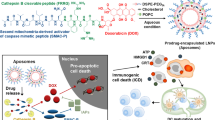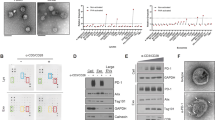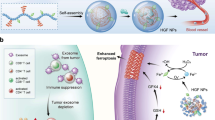Abstract
Purpose
Human Apo2-Ligand/TRAIL secreted by natural killer cells and cytotoxic T lymphocytes plays an important role immunosurveillance controlling tumor growth and metastasis. Moreover, the fact that Apo2L/TRAIL is capable of inducing cell death in tumor cells but not in normal cells makes this death ligand a promising anti-tumor agent. Previous data from our group demonstrated that Apo2L/TRAIL was physiologically released as transmembrane protein inserted in lipid vesicles, called exosomes. Recently, we demonstrated that artificial lipid nanoparticles coated with bioactive Apo2L/TRAIL (LUV-TRAIL) resembling the natural exosomes, greatly improved Apo2L/TRAIL activity and were able to induce apoptosis in hematological malignancies. In this study, we have deepened in the underlying mechanism of action of LUV-TRAIL in hematologic cells.
Methods/patients
Cytotoxic ability of LUV-TRAIL was assessed on Jurkat cells either over-expressing the anti-apoptotic protein Mcl1 or down-regulating the pro-apoptotic protein Bim previously generated in our laboratory. We also tested LUV-TRAIL cytotoxic ability against primary human leukemic cells from T-cell ALL patient.
Results
Silencing Bim but not Mcl-1 over-expression partially protects Jurkat cells from apoptosis induced by sTRAIL. LUV-TRAIL induced caspase-8 and caspase-3 activation and killed Jurkat-Mcl1 and Jurkat-shBim more efficiently than sTRAIL independently of the mitochondrial pathway. On the other hand, LUV-TRAIL were clearly more cytotoxic against primary leukemic cells from a T-cell ALL patient than sTRAIL.
Conclusion
Tethering Apo2L/TRAIL to the surface of lipid nanoparticles greatly increases its bioactivity and could be of potential use in anti-tumor therapeutics.






Similar content being viewed by others
References
Pitti RM, Marsters SA, Ruppert S, Donahue CJ, Moore A, Ashkenazi A. Induction of apoptosis by Apo-2 ligand, a new member of the tumor necrosis factor cytokine family. J Biol Chem. 1996;271:12687–90.
Wiley SR, Schooley K, Smolak PJ, Din WS, Huang CP, Nicholl JK, et al. Identification and characterization of a new member of the TNF family that induces apoptosis. Immunity. 1995;3:673–82.
Zerafa N, Westwood JA, Cretney E, Mitchell S, Waring P, Iezzi M, et al. Cutting edge: TRAIL deficiency accelerates hematological malignancies. J Immunol. 2005;175:5586–90.
Yerbes R, Palacios C, Lopez-Rivas A. The therapeutic potential of TRAIL receptor signalling in cancer cells. Clin Transl Oncol. 2011;13:839–47.
Lemke J, von Karstedt S, Zinngrebe J, Walczak H. Getting TRAIL back on track for cancer therapy. Cell Death Differ. 2014;21:1350–64.
Ashkenazi A. Directing cancer cells to self-destruct with pro-apoptotic receptor agonists. Nat Rev Drug Discov. 2008;7:1001–12.
Cuello M, Ettenberg SA, Nau MM, Lipkowitz S. Synergistic induction of apoptosis by the combination of trail and chemotherapy in chemoresistant ovarian cancer cells. Gynecol Oncol. 2001;81:380–90.
Ray S, Bucur O, Almasan A. Sensitization of prostate carcinoma cells to Apo2L/TRAIL by a Bcl-2 family protein inhibitor. Apoptosis. 2005;10:1411–8.
Ichikawa K, Liu W, Zhao L, Wang Z, Liu D, Ohtsuka T, et al. Tumoricidal activity of a novel anti-human DR5 monoclonal antibody without hepatocyte cytotoxicity. Nat Med. 2001;7:954–60.
Plummer R, Attard G, Pacey S, Li L, Razak A, Perrett R, et al. Phase 1 and pharmacokinetic study of lexatumumab in patients with advanced cancers. Clin Cancer Res. 2007;13:6187–94.
Tolcher AW, Mita M, Meropol NJ, von Mehren M, Patnaik A, Padavic K, et al. Phase I pharmacokinetic and biologic correlative study of mapatumumab, a fully human monoclonal antibody with agonist activity to tumor necrosis factor-related apoptosis-inducing ligand receptor-1. J Clin Oncol. 2007;25:1390–5.
Bernardi S, Secchiero P, Zauli G. State of art and recent developments of anti-cancer strategies based on TRAIL. Recent Pat Anticancer Drug Discov. 2012;7:207–17.
Micheau O, Shirley S, Dufour F. Death receptors as targets in cancer. Br J Pharmacol. 2013;169:1723–44.
Herbst RS, Eckhardt SG, Kurzrock R, Ebbinghaus S, O’Dwyer PJ, Gordon MS, et al. Phase I dose-escalation study of recombinant human Apo2L/TRAIL, a dual proapoptotic receptor agonist, in patients with advanced cancer. J Clin Oncol. 2010;28:2839–46.
Soria JC, Mark Z, Zatloukal P, Szima B, Albert I, Juhasz E, et al. Randomized phase II study of dulanermin in combination with paclitaxel, carboplatin, and bevacizumab in advanced non-small-cell lung cancer. J Clin Oncol. 2011;29:4442–51.
Martinez-Lorenzo MJ, Anel A, Gamen S, Monlen I, Lasierra P, Larrad L, et al. Activated human T cells release bioactive Fas ligand and APO2 ligand in microvesicles. J Immunol. 1999;163:1274–81.
Monleon I, Martinez-Lorenzo MJ, Monteagudo L, Lasierra P, Taules M, Iturralde M, et al. Differential secretion of Fas ligand- or APO2 ligand/TNF-related apoptosis-inducing ligand-carrying microvesicles during activation-induced death of human T cells. J Immunol. 2001;167:6736–44.
De Miguel D, Basanez G, Sanchez D, Malo PG, Marzo I, Larrad L, et al. Liposomes decorated with Apo2L/TRAIL overcome chemoresistance of human hematologic tumor cells. Mol Pharm. 2013;10:893–904.
Martinez-Lostao L, Garcia-Alvarez F, Basanez G, Alegre-Aguaron E, Desportes P, Larrad L, et al. Liposome-bound APO2L/TRAIL is an effective treatment in a rheumatoid arthritis model. Arthritis Rheum. 2010;62:2272–82.
MacFarlane M, Ahmad M, Srinivasula SM, Fernandes-Alnemri T, Cohen GM, Alnemri ES. Identification and molecular cloning of two novel receptors for the cytotoxic ligand TRAIL. J Biol Chem. 1997;272:25417–20.
Balsas P, Lopez-Royuela N, Galan-Malo P, Anel A, Marzo I, Naval J. Cooperation between Apo2L/TRAIL and bortezomib in multiple myeloma apoptosis. Biochem Pharmacol. 2009;77:804–12.
Lopez-Royuela N, Perez-Galan P, Galan-Malo P, Yuste VJ, Anel A, Susin SA, et al. Different contribution of BH3-only proteins and caspases to doxorubicin-induced apoptosis in p53-deficient leukemia cells. Biochem Pharmacol. 2010;79:1746–58.
Bene MC, Castoldi G, Knapp W, Ludwig WD, Matutes E, Orfao A, et al. Proposals for the immunological classification of acute leukemias. European Group for the Immunological Characterization of Leukemias (EGIL). Leukemia. 1995;9:1783–6.
Mirandola P, Ponti C, Gobbi G, Sponzilli I, Vaccarezza M, Cocco L, et al. Activated human NK and CD8+ T cells express both TNF-related apoptosis-inducing ligand (TRAIL) and TRAIL receptors but are resistant to TRAIL-mediated cytotoxicity. Blood. 2004;104:2418–24.
Wendling U, Walczak H, Dorr J, Jaboci C, Weller M, Krammer PH, et al. Expression of TRAIL receptors in human autoreactive and foreign antigen-specific T cells. Cell Death Differ. 2000;7:637–44.
Bae J, Leo CP, Hsu SY, Hsueh AJ. MCL-1S, a splicing variant of the antiapoptotic BCL-2 family member MCL-1, encodes a proapoptotic protein possessing only the BH3 domain. J Biol Chem. 2000;275:25255–61.
Gomez-Bougie P, Bataille R, Amiot M. The imbalance between Bim and Mcl-1 expression controls the survival of human myeloma cells. Eur J Immunol. 2004;34:3156–64.
Vela L, Gonzalo O, Naval J, Marzo I. Direct interaction of Bax and Bak proteins with Bcl-2 homology domain 3 (BH3)-only proteins in living cells revealed by fluorescence complementation. J Biol Chem. 2013;288:4935–46.
Geserick P, Wang J, Feoktistova M, Leverkus M. The ratio of Mcl-1 and Noxa determines ABT737 resistance in squamous cell carcinoma of the skin. Cell Death Dis. 2014;5:e1412.
Reynolds C, Roderick JE, Labelle JL, Bird G, Mathieu R, Bodaar K, et al. Repression of BIM mediates survival signaling by MYC and AKT in high-risk T-cell acute lymphoblastic leukemia. Leukemia. 2014;28:1819–27.
Jiang N, Koh GS, Lim JY, Kham SK, Ariffin H, Chew FT, et al. BIM is a prognostic biomarker for early prednisolone response in pediatric acute lymphoblastic leukemia. Exp Hematol. 2011;39:321–9 (e321–e323).
Cheong I, Huang X, Thornton K, Diaz LA Jr, Zhou S. Targeting cancer with bugs and liposomes: ready, aim, fire. Cancer Res. 2007;67:9605–8.
Gregoriadis G. Liposomes in therapeutic and preventive medicine: the development of the drug-carrier concept. Ann NY Acad Sci. 1978;308:343–70.
Loi M, Becherini P, Emionite L, Giacomini A, Cossu I, Destefanis E, et al. sTRAIL coupled to liposomes improves its pharmacokinetic profile and overcomes neuroblastoma tumour resistance in combination with Bortezomib. J Control Release. 2014;192:157–66.
Mitchell MJ, Wayne E, Rana K, Schaffer CB, King MR. TRAIL-coated leukocytes that kill cancer cells in the circulation. Proc Natl Acad Sci USA. 2014;111:930–5.
Seifert O, Pollak N, Nusser A, Steiniger F, Ruger R, Pfizenmaier K, et al. Immuno-LipoTRAIL: targeted delivery of TRAIL-functionalized liposomal nanoparticles. Bioconjug Chem. 2014;25:879–87.
Acknowledgments
We gratefully acknowledge Dr. Gorka Basáñez for supporting in LUV-TRAIL generation. We also gratefully acknowledge Dr. Henning Walczak for support throughout the years. This work was supported by Grants PI13/00416 (LML) from Instituto de Salud Carlos III, SAF2010-15341 (AA) from Ministerio de Ciencia e Innovación. DDM was supported by pre-doctoral fellowships from Gobierno de Aragón and an EMBO short-term Fellowship.
Conflict of interest
The authors declare that they have no competing interests. Alberto Anel and Luis Martinez-Lostao have filed a patent application (W02011020933) for the use of liposome-bound Apo2L/TRAIL.
Informed consent
Patient referred to this manuscript, voluntarily consented to participate in the study, and authorized that the corresponding data be used in the manuscript. The development of this study was properly approved and given ethics clearance by the Comité Ético de Investigación Clínica de Aragón; and the research was conducted in accordance with the Helsinki Declaration of 1975.
Author information
Authors and Affiliations
Corresponding author
Rights and permissions
About this article
Cite this article
De Miguel, D., Gallego-Lleyda, A., Galan-Malo, P. et al. Immunotherapy with liposome-bound TRAIL overcomes partial protection to soluble TRAIL-induced apoptosis offered by down-regulation of Bim in leukemic cells. Clin Transl Oncol 17, 657–667 (2015). https://doi.org/10.1007/s12094-015-1295-x
Received:
Accepted:
Published:
Issue Date:
DOI: https://doi.org/10.1007/s12094-015-1295-x




